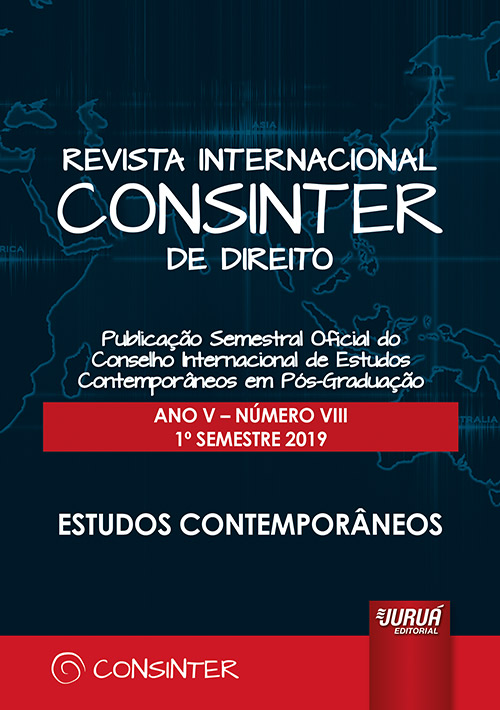The Single Tax Principle As A Limit To Double Non-Taxation? A Broad Perspective
DOI:
https://doi.org/10.19135/revista.consinter.00008.23Palavras-chave:
Double non-taxation, International tax competition, Single tax principleResumo
In recent years, double non-taxation phenomenon has gained some importance. This phenomenon means that income is not subject to tax anywhere. Based on a purported international tax regime, some academics have defended the existence of a single tax principle which prohibits double taxation as well as double non-taxation.
From a political standpoint, States enjoy fiscal sovereignty in order to design the rules to accomplish their own fiscal policies. In the current economic context of globalization, countries compete with each other in order to attract foreign investment and capital. To achieve these goals, countries use fiscal instruments, such as public expenditure or taxes. Nevertheless, countries are different from each other and may have different goals in consideration of their preferences. There are countries that base their competitiveness on offering good public infrastructures, whereas other countries are focused on low taxation to attract foreign investment, and even there are other countries, due to their economic structure, able to secure good public infrastructures with low taxes. Therefore, a country is free and sovereign to “untax” the income over which it has tax powers.
The question is whether there are limits to the tax sovereignty of countries so that they may prohibit certain forms of double non-taxation. These supranational limits might be identified in the structure of the international tax regime. These attributes of the international tax regime inform largely the tax legislation of the international community. Those principles are the interpersonal equity or ability-to-pay principle, the neutrality principle, and the justice in the allocation of the taxing powers or internation equity principle. Nevertheless, from a positivistic and public international law standpoint, these supranational principles do not bind countries to hold a minimum threshold of taxation.
Downloads
Referências
Arora, J., Sheppard, L. A., & Madara, M. R. (2013). Does Revised OECD Intangibles Guidance Signal a Shift? Tax Notes.
Ault, H. J. (2013). Some Reflections on the OECD and the Sources of International Tax Principles. Tax Notes International, 70, 1195–1201. DOI: https://doi.org/10.2139/ssrn.2287834
Avi-Yonah, R. S. (1997). International Taxation of Electronic Commerce. Tax Law Review, 52, 507–556. DOI: https://doi.org/10.2139/ssrn.3920270
Avi-Yonah, R. S. (2000a). Commentary (Response to article by H. David Rosenbloom). Tax Law Review, 53, 167–175.
Avi-Yonah, R. S. (2000b). Globalization, Tax Competition, and the Fiscal Crisis of the Welfare State. Harvard Law Review, 113, 1573–1676. DOI: https://doi.org/10.2307/1342445
Avi-Yonah, R. S. (2007). International Tax as International Law. An Analysis of the International Tax Regime. New York: Cambridge University Press. DOI: https://doi.org/10.1017/CBO9780511511318
Avi-Yonah, R. S. (2015). Who Invented the Single Tax Principle?: An Essay on the History of U.S. Treaty Policy. New York Law School Law Review, 59, 309–319.
Bammens, N. (2012). The Principle of Non-discrimination in International and European Tax Law (Vol. 24). Amsterdam: IBFD.
Bracewell Milnes, B. (2001). Economic Taxable Capacity. Intertax, 29, 114–114. DOI: https://doi.org/10.54648/333789
Bracewell Milnes, B. (2003). Is Tax Avoidance Harmful? Intertax, 31, 96. DOI: https://doi.org/10.54648/TAXI2003021
Brauner, Y. (2003). An International Tax Regime in Crystallization. Tax Law Review, 56, 259–328.
Caamaño Anido, M. Á., & Calderón Carrero, J. M. (2002). Globalización Económica y Poder Tributario: ¿Hacia un Nuevo Derecho Tributario? Anuario de La Facultad de Derecho de La Universidad de La Coruña, 6, 179–209.
Calderón Carrero, J. M. (2010). La Globalización Económica y sus Implicaciones para el Derecho Financiero y Tributario (pp. 175–202). Presented at the VII Congreso de Academis Jurídicas y Sociales de Iberoamérica y Filipinas, A Coruña: Real Academia Gallega de Jurisprudencia y Legislación.
Calderón Carrero, J. M. (2012). La Globalización Económica y su Incidencia sobre el Derecho Financiero y Tributario: ¿Implicaciones sobre la Protección de los Bienes Jurídicos Globales? Anuario de La Facultad de Derecho de La Universidad Autónoma de Madrid, 16, 337–366.
Christians, A. (2007). Hard Law, Soft Law, and International Taxation. Wisconsin International Law Journal, 25, 325–333.
Dagan, T. (1998). National Interests in the International Tax Game. Virginia Tax Review, 18, 363–416.
Dagan, T. (2000). The Tax Treaties Myth. Journal of International Law and Politics, 32, 939–996.
Dourado, A. P. (2015). Aggressive Tax Planning in EU Law and in the Light of BEPS: The EC Recommendation on Aggressive Tax Planning and BEPS Actions 2 and 6. Intertax, 43, 42–57. DOI: https://doi.org/10.54648/TAXI2015004
Dubut, T. (2012). France. In M. Lang, P. Pistone, J. Schuch, C. Staringer, & A. Storck (Eds.), Tax Rules in Non-Tax Agreements (pp. 315–358). Amsterdam: IBFD.
Engelen, F. (2008). How ‘Acquiescence’ and ‘Estoppel’ Can Operate to the Effect that the States Parties to a Tax Treaty Are Legally Bound to Interpret the Treaty in Accordance with the Commentaries on the OECD Model Tax Convention. In S. Douma & F. Engelen (Eds.), The Legal Status of the OECD Commentaries (pp. 51–72). Amsterdam: IBFD.
Fleming, J. C., Peroni, R. J., & Shay, S. E. (2001). Fairness in International Taxation: The Ability-to-Pay Case for Taxing Worldwide Income. Florida Tax Review, 5, 299–354. DOI: https://doi.org/10.5744/ftr.2001.1004
Friedmann, W. (1964). The Changing Structure of International Law. New York: Columbia University Press.
García Prats, F. A. (2010). The ‘Abuse of Tax Law’: Prospects and Analysis. In G. Bizioli (Ed.), Essays in International and European Tax Law (pp. 49–148). Nápoles: Jovene.
González Martínez, M. T. (2010). Convenios para Evitar la Doble Imposición: Interpretación y Alcance. In L. Cruz de Quiñones (Ed.), Lecciones de Derecho Tributario Inspiradas por un Maestro: Tomo I. Liber Amicorum en Homenaje a Eusebio González García (pp. 576–605). Bogotá: Universidad del Rosario e Instituto Colombiano de Derecho Tributario.
Graetz, M. J. (2001). The David R. Tillinghast Lecture: Taxing International Income – Inadequate Principles, Outdated Concepts, and Unsatisfactory Policy. Tax Law Review, 54, 261–336.
Green, J. A. (2016). The Persistent Objetor Rule in International Law. Oxford University Press.
Green, R. A. (1993). The Future of Source-Based Taxation of the Income of Multinational Enterprises. Cornell Law Review, 79, 18–86.
Gribnau, H. (2008). Soft Law and Taxation: EU and International Aspects. Legisprudence, 2, 67–117. DOI: https://doi.org/10.1080/17521467.2008.11424674
Gutmann, D. (2011). Taking Human Rights Seriously: Some Introductory Words on Human Rights, Taxation and the EU. In G. Kofler, M. Poiares Maduro, & P. Pistone (Eds.), Human Rights and Taxation in Europe and the World (pp. 105–112). Amsterdam: IBFD.
Happé, R. (2007). Multinationals, Enforcement Covenants and Fair Share. Intertax, 35, 537–547. DOI: https://doi.org/10.54648/TAXI2007060
Herrera Molina, P. M. (1998). Capacidad Económica y Sistema Fiscal: Análisis del Ordenamiento Español a la Luz del Derecho Alemán. Marcial Pons.
Hillgenberg, H. (1999). A Fresh Look at Soft Law. European Journal of International Law, 10, 499–515. DOI: https://doi.org/10.1093/ejil/10.3.499
International Bar Association’s Human Rights Institute. (2013). Tax Abuses, Poverty and Human Rights. International Bar Association.
Kane, M. A. (2004). Strategy and Cooperation in National Responses to International Tax Arbitrage. Emory Law Journal, 53, 89–170.
Kaplow, L. (1989). Horizontal Equity: Measures in Search of a Principle. National Tax Journal, 42, 139–154. DOI: https://doi.org/10.1086/NTJ41788784
Kaufman, N. H. (1998). Fairness ad the Taxation of International Income. Law and Policy in International Business, 29, 145–203.
Kleinbard, E. D. (2011). Stateless Income. Florida Tax Review, 11, 699–774. DOI: https://doi.org/10.5744/ftr.2011.1009
Lampreave, P. (2011). Fiscal Competitiveness versus Harmful Tax Competition in the European Union. Bulletin for International Taxation, 65(6). DOI: https://doi.org/10.2139/ssrn.1932257
Lang, M. (2004). General Report. In IFA (Ed.), Double Non-Taxation, Cahiers de droit fiscal international, vol. 89a (pp. 73–119).
Lepard, B. D. (1999). Is the United States Obligated to Drive on the Right? A Multidisciplinary Inquiry into the Normative Authority of Contemporary International Law Using the Arm´s Length Standard as a Case Study. Duke Journal of Comparative and International Law, 10, 43–180.
Lepard, B. D. (2010). Customary International Law. A New Theory with Practical Applications. Cambridge University Press. DOI: https://doi.org/10.1017/CBO9780511804717
Lodin, S.-O. (2000). What Ought To Be Taxed and What Can Be Taxed: A New International Dilemma. Bulletin for International Taxation, 54, 210–217.
Lokken, L. (2012). What Is This Thing Called Source? In Y. Brauner & M. J. McMahon Jr. (Eds.), The Proper Tax Base: Structural Fairness from an International and Comparative Perspective- Essays in Honor of Paul McDaniel (pp. 139–148). Alphen aan den Rijn: Kluwer Law International.
López Espadafor, C. M. (2006). La Costumbre Internacional en el Derecho Tributario. Nueva Fiscalidad, 9–42.
McDougal, M. S., & Reisman, W. M. (1965). ‘The Changing Structure of International Law’: Unchanging Theory for Inquiry. Columbia Law Review, 65, 810–835. DOI: https://doi.org/10.2307/1120746
McLure, C. E. (2001). Globalization, Tax Rules and National Sovereignty. Bulletin for International Fiscal Documentation, 55, 328–341.
Musgrave, R. A. (1959). The Theory of Public Finance: A Study in Public Economy. McGraw-Hill. DOI: https://doi.org/10.1007/978-1-349-23426-4
Musgrave, R. A. (1990). Horizontal Equity, Once More. National Tax Journal, 43, 113–122. DOI: https://doi.org/10.1086/NTJ41788830
Palao Taboada, C. (2009). La Aplicación de las Normas Tributarias y la Elusión Fiscal (Primera). Valladolid: Lex Nova.
Pastor Ridruejo, J. A. (2009). Curso de Derecho Internacional Público y Organizaciones Internacionales (13th ed.). Madrid: Tecnos.
Picciotto, S. (2016). Towards Unitary Taxation: Combined Reporting and Formulary Apportionment. In T. Pogge & K. Mehta (Eds.), Global Tax Fairness (pp. 221–237). Oxford: Oxford University Press. DOI: https://doi.org/10.1093/acprof:oso/9780198725343.003.0010
Pistone, P., Julien, R., & Cannas, F. (2016). Can the Derivative Benefits Provision and the Competent Authority Discretionary Relief Provision Render the OECD-Proposed Limitation on Benefits Clause Compatible with EU Fundamental Freedoms? In M. Lang, P. Pistone, A. Rust, J. Schuch, & C. Staringer (Eds.), Base Erosion and Profit Shifting (BEPS): The Proposals to Revise de OECD Model Convention (pp. 165–218). Viena: Linde.
Repetti, J. R., & McDaniel, P. R. (1993). Horizontal and Vertical Equity: The Musgrave/Kaplow Exchange. Florida Tax Review, 1, 607–622. DOI: https://doi.org/10.5744/ftr.1993.1102
Repetti, J. R., & Ring, D. M. (2012). Horizontal Equity Revisited. In Y. Brauner & M. J. McMahon Jr. (Eds.), The Proper Tax Base. Structural Fairness from an International and Comparative Perspective – Essays in Honor of Paul McDaniel (pp. 121–137). Alphen aan den Rijn: Kluwer Law International.
Ring, D. M. (2002). One Nation Among Many: Policy Implications of Cross-Border Tax Arbitrage. Boston College Law Review, 44, 79–175. DOI: https://doi.org/10.2139/ssrn.417560
Roin, J. (2000). Competition and Evasion: Another Perspective on International Tax Competition. Georgetown Law Journal, 89, 543–604.
Rosembuj, T. (2011). La Crisis Financiera y el Arbitraje Fiscal Internacional (Primera). Barcelona: El Fisco.
Rosenbloom, H. D. (2000). The David R. Tillinghast Lecture. International Tax Arbitrage and the ‘International Tax System’. Tax Law Review, 53, 137–166.
Rosenzweig, A. H. (2007). Harnessing the Costs of International Tax Arbitrage. Virginia Tax Review, 26, 555–630.
Santa-Bárbara Rupérez, J. (2001). La No Discriminación Fiscal. Edersa.
Scapa, A., & Henie, L. A. (2005). Avoidance of Double Non-Taxation under the OECD Model Tax Convention. Intertax, 33, 266–285. DOI: https://doi.org/10.54648/TAXI2005048
Serrano Antón, F. (2014). El Informe sobre Erosión de Bases Imponibles y Traslación de Beneficios de la OCDE: Origen e Implementación en un Marco Internacional y Globalizado. Revista de Derecho PUCP, 72, 45–70. DOI: https://doi.org/10.18800/derechopucp.201401.003
Serrano Antón, F. (2015). La Influencia del Plan de Acción BEPS en la Tributación Española: Impacto en la Normativa, Incremento de la Litigosidad y el Papel de los Tribunales. Revista de Contabilidad Y Tributación CEF, (391), 77–110. DOI: https://doi.org/10.51302/rcyt.2015.4937
Singh, K., & Mathur, A. (2013). BEPS and the Law of Unintended Consequences. Tax Notes, 1331–1338.
Smit, D. S. (2012). The Netherlands. In M. Lang, P. Pistone, J. Schuch, C. Staringer, & A. Storck (Eds.), Tax Rules in Non-Tax Agreements (pp. 535–596). Amsterdam: IBFD.
Thomas, C. (1996). Customary International Law and State Taxation of Corporate Income: The Case for the Separate Accounting Method. Berkeley Journal of International Law, 14, 99–136.
Tiebout, C. M. (1956). A Pure Theory of Local Expenditures. The Journal of Political Economy, 64, 416–424. DOI: https://doi.org/10.1086/257839
Ting, A. (2014). iTax—Apple’s International Tax Structure and the Double Non-Taxation Issue. British Tax Review, 40–71.
Tomazela Santos, R. (2015). Prevention of Hybrid Mismatches as a Justification? In K. Dziurdz & C. Marchgraber (Eds.), Non-Discrimination in European and Tax Treaty Law. Open Issues and Recent Challenges (pp. 163–194). Viena: Linde.
Van de Vijver, A. (2015). International Double (Non-)taxation: Comparative Guidance from European Legal Principles. EC Tax Review, 24, 240–257. DOI: https://doi.org/10.54648/ECTA2015025
Vega Borrego, F. A. (2003). Las Medidas contra el Treaty Shopping. Las Cláusulas de Limitación de Beneficios en los Convenios de Doble Imposición. Madrid: Ministerio de Hacienda – Instituto de Estudios Fiscales.
Vogel, K. (1986). Double Tax Treaties and Their Interpretation. International Tax & Business Lawyer, 4, 1–85.
Vogel, K. (1988). Worldwide vs. Source Taxation of Income- A Review and Re-evaluation of Arguments (Part 1). Intertax, 16, 216–229. DOI: https://doi.org/10.54648/TAXI1988043
Webb, M. C. (2004). Defining the Boundaries of Legitimate State Practice: Norms, Transnational Actors and the OECD’s Project on Harmful Tax Competition. Review of International Political Economy, 11, 787–827. DOI: https://doi.org/10.1080/0969229042000279801
Wilson, G. P. (1993). The Role of Taxes in Location and Sourcing Decisions. In A. Giovannini, R. G. Hubbard, & J. Slemrod (Eds.), Studies in International Taxation (pp. 195–234). University of Chicago Press.
Wilson, J. D. (1999). Theories of Tax Competition. National Tax Journal, 52, 269–304. DOI: https://doi.org/10.1086/NTJ41789394
Zodrow, G. R. (2010). Capital Mobility and Tax Competition. National Tax Journal, 63, 865–902. DOI: https://doi.org/10.17310/ntj.2010.4S.03
Zodrow, G. R., & Mieszkowski, P. (1986). Pigou, Tiebout, Property Taxation, and the Underprovision of Local Public DOI: https://doi.org/10.1016/0094-1190(86)90048-3
Downloads
Publicado
Como Citar
Edição
Seção
Licença
Copyright (c) 2019 Alejandro Zubimendi

Este trabalho está licenciado sob uma licença Creative Commons Attribution-NonCommercial-ShareAlike 4.0 International License.
Para fins da universalização e compartilhamento livre dos saberes a Revista do CONSINTER está indexada sob a Licença Creative Commons 4.0
Atribuição – Uso Não Comercial – Compartilhamento pela mesma licença 4.0 Brasil.
É permitido:
– Copiar, distribuir, exibir e executar a obra
– Criar obras derivadas
Sob as seguintes condições:
ATRIBUIÇÃO
Você deve dar crédito ao autor original, da forma especificada pelo autor ou licenciante.
USO NÃO COMERCIAL
Você não pode utilizar esta obra com finalidades comerciais.
COMPARTILHAMENTO PELA MESMA LICENÇA
Se você alterar, transformar ou criar outra obra com base nesta, você somente poderá distribuir a obra resultante sob uma licença idêntica a esta.
Para cada novo uso ou distribuição, você deve deixar claro para outro, os termos da licença desta obra.
Licença Jurídica (licença integral): https://creativecommons.org/licenses/by-nc-sa/4.0/deed.pt_BR









